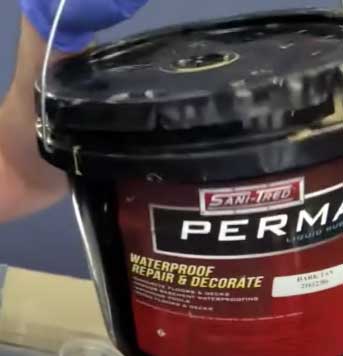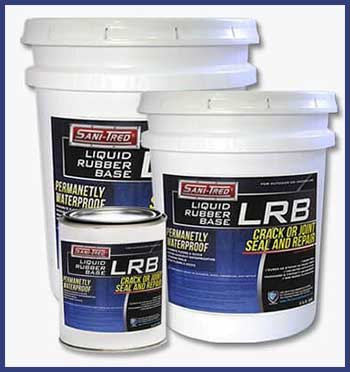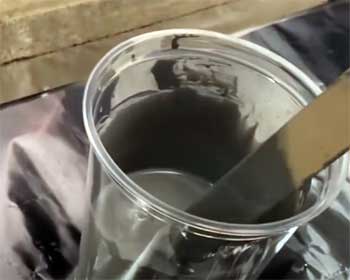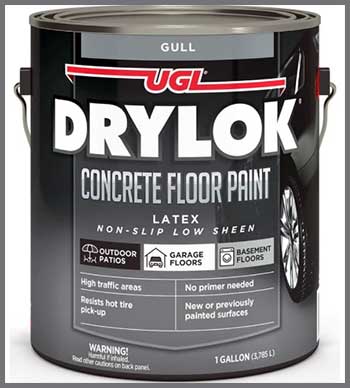Let me tell you, when I first stumbled across SANI-TRED, I was skeptical. Waterproofing products often promise the world but deliver a leaky mess. Yet, after using SANI-TRED on my basement and outdoor patio, I’m a believer.
This stuff isn’t just another coating—it’s a robust, long-lasting solution that’s transformed how I tackle water damage. Whether you’re battling a damp basement or protecting a concrete deck, SANI-TRED delivers results that make it worth every penny.
Trust me, if you’re looking for peace of mind, this is the product to buy.
My Journey With SANI-TRED: A Real-World Experience

Picture this: my basement was a disaster.
Every heavy rain turned it into a swampy mess, with water seeping through cracks in the concrete like it was mocking me.
I’d tried everything—cheap sealants, patching compounds, even a dehumidifier that ran 24/7.
Nothing worked long-term. Then, I found SANI-TRED.
I’ll admit, I was hesitant to spend money on yet another product, but the reviews were promising, and I was desperate.
Applying SANI-TRED was surprisingly straightforward. I started with their LRB (Liquid Rubber Base), which went on like a thick paint. It clung to the concrete like nobody’s business, filling every crack and crevice.
Next came the PermaFlex topcoat, which added a tough, flexible layer. The first time I saw water bead up and roll off after a storm, I nearly cried with relief. My basement stayed bone-dry, even during a week of relentless rain.
I also used it on my outdoor patio, which had been stained and slippery from years of weathering. After applying SANI-TRED, the surface looked revitalized and felt safer underfoot.
What struck me most was the durability. Months later, there’s no peeling, no cracking, just a solid barrier that laughs in the face of moisture. I’ve walked on it, spilled coffee on it, even dragged heavy furniture across it—zero damage.
It’s not just a product; it’s a solution that gave me back my basement and peace of mind. If you’re dealing with water issues or want to protect your surfaces, SANI-TRED is worth a serious look.
What Makes SANI-TRED Stand Out?
Let’s talk about why SANI-TRED has earned a permanent spot in my home improvement arsenal. This isn’t your average waterproofing paint—it’s a system designed to bond with surfaces at a molecular level.
The folks at SANI-TRED claim their Liquid Rubber Base penetrates deep into concrete, wood, or even metal, creating a seamless, flexible barrier. Unlike traditional sealants that sit on top and eventually crack, SANI-TRED becomes part of the surface. I’ve seen it in action, and it’s no exaggeration.
The system includes three main components: the LRB, PermaFlex, and TAV (Thickening Activator). The LRB is the star, sinking into porous surfaces to seal them tight. PermaFlex adds a durable, UV-resistant topcoat, perfect for outdoor areas.
The TAV is optional but handy for patching deep cracks or creating a textured finish. Together, they form a waterproofing powerhouse that’s flexible enough to handle temperature changes and surface movement without breaking.
I also appreciate how versatile it is. I used it on my concrete basement floor, but it works on wood decks, metal tanks, even boat hulls. It’s like the Swiss Army knife of waterproofing. Plus, it’s non-toxic and low-odor, so I didn’t have to evacuate my house during application.
The fact that it’s made in the USA and backed by a lifetime warranty gave me extra confidence. This isn’t a fly-by-night product—it’s built to last.
Pros of SANI-TRED: Why I’m Sold
- Unmatched Durability

I can’t stress enough how tough SANI-TRED is.
After applying it to my patio, I’ve put it through the wringer—foot traffic, harsh weather, even a clumsy moment when I dropped a hammer.
Not a scratch. The flexibility is key; it moves with the surface, so it doesn’t crack when temperatures swing from freezing to scorching.
I’ve seen other coatings peel within months, but SANI-TRED looks as good as the day I applied it.
- Easy Application
You don’t need to be a pro to use SANI-TRED. I’m no handyman, but the process was manageable. The LRB goes on with a roller or brush, and PermaFlex follows suit. The instructions are clear, and the product is forgiving if you make a mistake.
I spilled some LRB on my workbench, and it wiped up easily before it cured. Cleanup is simple too—just soap and water for tools. For someone like me who dreads complicated projects, this was a breath of fresh air.
- Versatility Across Surfaces
One of SANI-TRED’s biggest strengths is its ability to stick to almost anything. I’ve used it on concrete and wood, but it’s also rated for metal, fiberglass, and more.
This makes it a go-to for everything from basements to boat docks. I’m already planning to use it on my wooden fence next spring. Knowing one product can handle multiple projects saves me time and money.
- Long-Term Cost Savings
Sure, SANI-TRED isn’t the cheapest option upfront, but it’s an investment. By preventing water damage, it’s saved me from costly repairs. My basement used to need constant maintenance—patching cracks, replacing drywall.
Since using SANI-TRED, those expenses are gone. Plus, the lifetime warranty means I’m covered if anything goes wrong, though I doubt I’ll need it.
- Eco-Friendly and Safe
I was pleasantly surprised by how user-friendly SANI-TRED is. The low-odor formula meant I could work indoors without feeling like I was in a chemical plant. It’s non-toxic once cured, which is great since my kids play in the basement.
Knowing it’s environmentally friendly adds to the appeal—I don’t feel like I’m harming the planet to protect my home.
Cons of SANI-TRED: The Not-So-Perfect Side
- Higher Initial Cost

Let’s be real—SANI-TRED isn’t cheap.
Compared to generic sealants at the hardware store, it’s a bigger upfront investment.
I winced a bit when I saw the price tag, but after wasting money on inferior products, I realized you get what you pay for.
If you’re on a tight budget, the cost might sting, but I’d argue it’s worth it for the long-term savings.
- Curing Time Can Be a Hassle
Patience isn’t my strong suit, and SANI-TRED tested me. The LRB needs 24-48 hours to cure before you apply PermaFlex, and the topcoat takes another day or two to fully set. If you’re in a rush, this can feel like forever.
I had to plan my project over a long weekend to avoid disrupting my household. It’s not a dealbreaker, but it’s something to consider.
- Requires Proper Prep
SANI-TRED isn’t a slap-it-on-and-go product. You need to prep your surface thoroughly—cleaning, degreasing, and sometimes sanding. I spent a solid afternoon scrubbing my basement floor to ensure it was spotless.
If you skip this step, the product won’t bond properly, and you’ll be disappointed. It’s not hard, but it’s time-consuming, especially for larger areas.
- Limited Color Options
If aesthetics matter to you, SANI-TRED’s color selection is a bit underwhelming. It comes in standard colors like gray, white, and black, but don’t expect a rainbow of options.
I went with gray for my basement, which looks fine, but I would’ve loved a custom shade for my patio. You can paint over it, but that’s an extra step.
Maintenance Tips For Keeping SANI-TRED In Top Shape
- Regular Cleaning Keeps It Pristine
To keep your SANI-TRED surface looking and performing its best, clean it regularly. I sweep my patio weekly to remove dirt and debris, then hose it down with a mild soap solution. For my basement, a damp mop with a gentle cleaner does the trick.
Avoid harsh chemicals like bleach or ammonia—they can degrade the coating over time. I learned this the hard way when I used a strong cleaner and noticed a slight dulling. Stick to mild detergents, and your surface will stay vibrant.
- Inspect for Damage Annually
Even though SANI-TRED is tough, it’s smart to check for wear and tear once a year. I walk my patio and basement with a flashlight, looking for cracks or areas where the coating might have lifted.
So far, I’ve found nothing, but if you spot damage, patch it with a small batch of LRB and PermaFlex. The key is catching issues early before water sneaks in. This takes me about 30 minutes a year and gives me peace of mind.
- Avoid Heavy Abrasion
SANI-TRED can handle a lot, but it’s not invincible. I made the mistake of dragging a metal chair across my patio, which left a faint scuff. To prevent this, use furniture pads or lift heavy items instead of dragging them.
For high-traffic areas, consider adding a rug or mat to reduce wear. This is especially important for indoor spaces like basements where kids or pets might be rough on the surface.
- Reapply Topcoat as Needed
While SANI-TRED’s base layer is virtually permanent, the PermaFlex topcoat may need refreshing every 5-10 years, depending on exposure. My patio gets intense sun, so I’m planning to reapply PermaFlex in a few years to maintain UV protection.
The process is simple—just clean the surface, apply a new layer, and let it cure. It’s like giving your surface a new lease on life without redoing the whole job.
- Protect Against Extreme Conditions
If you live in an area with brutal winters or scorching summers, take extra care. I salt my patio in winter to prevent ice, but I rinse it thoroughly in spring to avoid salt buildup.
For hot climates, ensure the surface stays clean to prevent dust from baking into the coating. These small steps extend the life of your SANI-TRED application significantly.
Comparing SANI-TRED To Other Brands
- DryLok: Affordable but Less Durable

DryLok is a popular choice for basement waterproofing, and I’ve used it before.
It’s cheaper than SANI-TRED, which is tempting, but it didn’t hold up for me. DryLok forms a rigid coating that cracked when my foundation shifted slightly.
SANI-TRED’s flexibility is a game-changer here—it moves with the surface, preventing cracks.
DryLok also required frequent reapplication, whereas SANI-TRED feels like a one-and-done solution.
If you’re on a budget, DryLok might work for minor issues, but for serious waterproofing, SANI-TRED is superior.
- Rust-Oleum EpoxyShield: Solid but Limited
Rust-Oleum’s EpoxyShield is another contender I’ve tried, especially for garage floors. It’s durable and resists chemicals well, which is great for oily spills. However, it’s not as versatile as SANI-TRED. EpoxyShield struggled on my damp basement walls, where moisture caused it to peel. SANI-TRED’s ability to bond with wet surfaces is a huge advantage. EpoxyShield also has a stronger odor during application, which was a headache in confined spaces. For specific uses like garages, EpoxyShield is decent, but SANI-TRED’s range of applications makes it more practical.
- Kilz Waterproofing Paint: Basic and Temporary
Kilz makes a waterproofing paint that’s easy to find and apply, but it’s more of a quick fix. I used it on a small concrete porch years ago, and while it worked initially, it started flaking after a year of rain and sun.
SANI-TRED’s molecular bonding creates a permanent seal, whereas Kilz feels like a surface-level bandage. Kilz is also limited to concrete and masonry, so it’s not an option for wood or metal. If you need a cheap, temporary solution, Kilz might do, but SANI-TRED is the long-term winner.
- Flex Seal: Gimmicky and Inconsistent
Flex Seal’s spray-on rubber caught my attention with its flashy ads, but it was a letdown. I tested it on a leaky gutter, and while it worked for a season, it cracked under UV exposure. SANI-TRED’s PermaFlex topcoat is far more resilient to sunlight and weathering.
Flex Seal is also messy to apply, with overspray everywhere. SANI-TRED’s brush-on system is cleaner and more precise. Flex Seal might be fun for small DIY projects, but for serious waterproofing, it doesn’t hold a candle to SANI-TRED.
Frequently Asked Questions (FAQ)
Yes, you can paint over SANI-TRED, but there’s a catch. The PermaFlex topcoat accepts most water-based or latex paints, but you need to ensure the surface is clean and fully cured first. I painted my basement floor with a latex topcoat to match my decor, and it adhered well after a light sanding. Oil-based paints are trickier—they might not bond properly without a primer. Always test a small area first. Painting over SANI-TRED doesn’t affect its waterproofing, so you can customize the look without compromising performance.
Applying SANI-TRED is straightforward but requires care. Start by cleaning the surface—remove dirt, grease, and loose material. I used a pressure washer for my patio and a degreaser for my basement. Apply the LRB with a roller or brush, working it into cracks. Let it cure for 24-48 hours. Then, apply PermaFlex the same way, ensuring even coverage. For deep cracks, mix LRB with TAV for a thicker patch. Work in small sections to avoid mistakes. Ventilation is key, but the low odor makes it manageable. Follow the instructions, and you’ll get a professional result.
Absolutely, PermaFlex works like a charm. It’s the topcoat in the SANI-TRED system, providing a tough, UV-resistant layer over the LRB. I used it on my patio, and it’s held up against sun, rain, and foot traffic without fading or peeling. It’s flexible, so it handles temperature changes without cracking, unlike rigid coatings I’ve tried. PermaFlex also adds a slight sheen that makes surfaces look polished. It’s not a standalone product, though—it needs the LRB base to work its magic. Together, they’re unstoppable.
Why SANI-TRED Is My Go-To Waterproofing Solution?
After years of battling leaks and weathering, SANI-TRED has been a revelation. It’s transformed my basement and patio, saving me from endless repairs and stress. Its durability, versatility, and ease of use make it a standout, despite the higher cost and curing time.
If you want a waterproofing solution that delivers lasting results, SANI-TRED is the way to go. Don’t waste money on temporary fixes—invest in this system and enjoy the peace of mind you deserve.

Great information everything you had mentioned was spot on and I really liked the info about being able to paint over the San-Tred thanks so much.